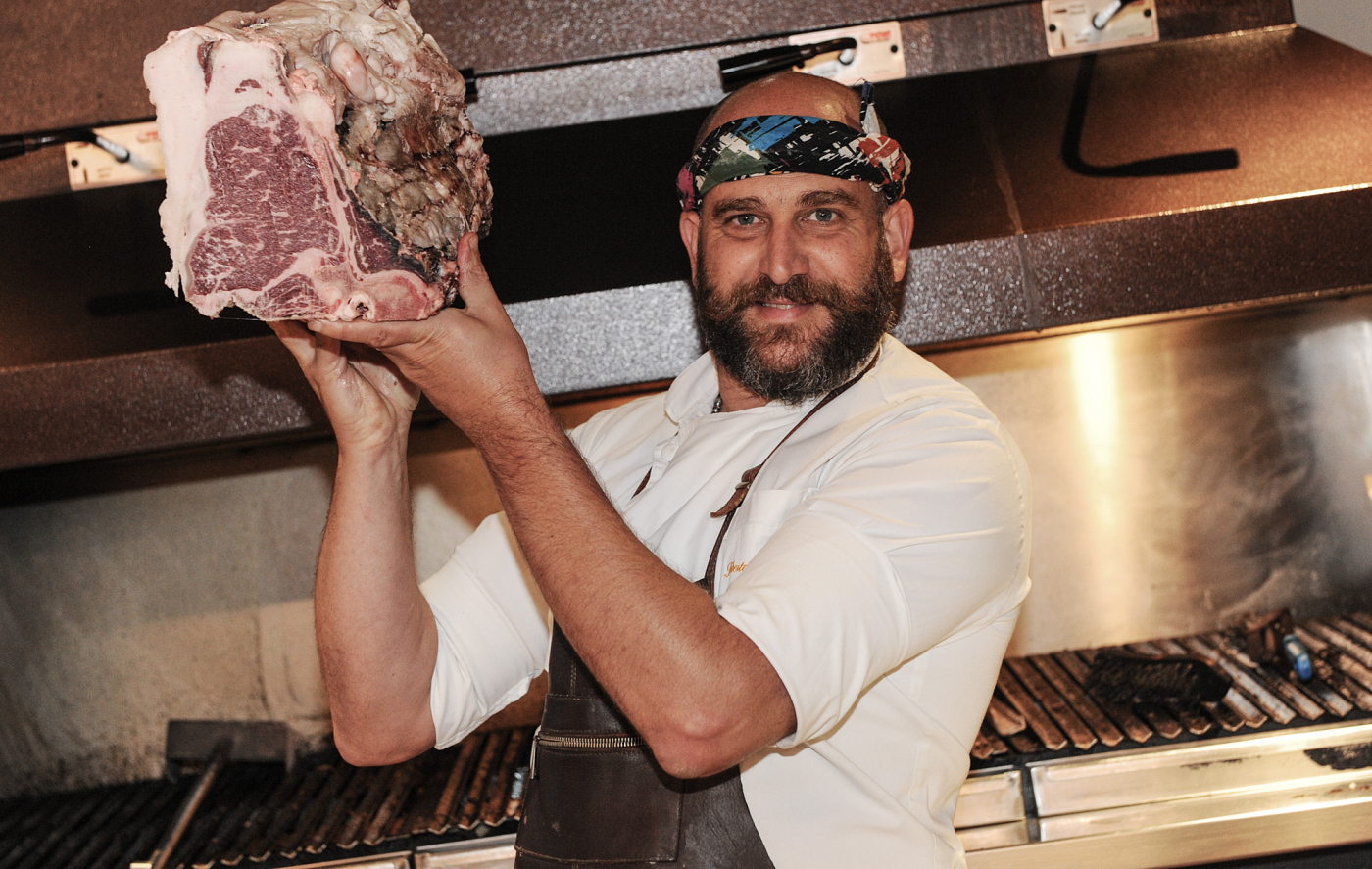
Fassona beef | Review: Bifrò la Bistecca Frollata, Turin
From a light tartare dish to 70-day aged dairy cow, David J. Constable works his way through some of the most extraordinary rare beef in Turin, at Bifrò

From a light tartare dish to 70-day aged dairy cow, David J. Constable works his way through some of the most extraordinary rare beef in Turin, at Bifrò

Roberto Pintadu stands hunched over the grill, his chef whites blood-speckled and messy. The bearded, bovine overlord is wearing a red-yellow flame bandanna tied around his forehead like Rambo’s headband. From where I’m sitting, I can see splendid ribbons of fire dance on gargantuan hunks of chargrilled Flintstone meat.
This is a region that prides itself on this unique breed of cow, renowned for their muscular hypertrophy, commonly known as double muscling
A purveyor of prime cuts, Roberto has his finger on the pulse of local agriculture, establishing relationships with farmers and monitoring their yield – a cow doesn’t fart in Piedmont without Roberto knowing about it. He lives for this stuff, pervertedly so; chewing my ear off about acidity increase, enzymes and how hanging dead cows in a specific way, for a particular duration of time, in special refrigerators, results in the perfect spring of bovine.

Bifrò, Turin
These well-stocked refrigerators reveal the restaurant’s intent and a procession of what guests can expect on their plates: great hunky, hanging, maturing cow quads; marbled fatty buttocks and slabs of rump, flank and shank labelled and dated, their origin advertised: ANGUS (Scottish, American and Italian), KAGOSHIMA WAGYU, WAGYU USA SNAKE FARM, FIORENTINA SASHI CHOCO FINLAND, PIEMONTE LOMBATIA, PIEMONTE FASSONA.
Set in Precollina Torinese, Turin’s affluent riverside neighbourhood, regulars include the city’s manufacturing and media elites, as well as the odd Juventus player. The room, though, is far from those leathery, clubbable steak lounges of yesterday and is casually relaxed, staffed by young, enthusiastic waiters, led by Roberto’s wife, Laura. She works the tables with agreeable grins and ciaos, schmoozing with the free-spending regulars and prepared for knowledgeable discussions about dry-ageing, grass-fed versus corn-fed and the holy Fassona communion.
For the Piedmontese, a slab of Fassona is symbolic of something other. This is a region that prides itself on this unique breed of cow, renowned for their muscular hypertrophy, commonly known as double muscling. This peculiar makeup gives a high slaughter yield, greater tenderness and a special flavouring, plus the lowest content of fat and cholesterol among breeds. To these Polentone carnivores, that profile with the prehistoric sizzle of beef on the burner is unrivalled.

Bifrò, Turin
Things kick-off, however, with the prized Fassona prepared in its most simplistic form: a tartare suitably raw and simply seasoned with salt and extra-virgin olive oil, accompanied by the earthy flavours of early-season porcini and Caesar’s mushrooms, and a sprightly glass of chilled Contratto Blanc de Blancs, 2015 to pair.
A trio of cured ham then arrives: a smoked and salted 12-month from León in northwest Spain, another smoked from Verona and a splendid local salami from the Gavazza brothers in Asti. The pace picks up with the introduction of A5 wagyu, cubed to reveal soft, pink marbling and punctured with a stick for consumption ease – each cube tender and sweet, oozing meat juices.
Then, snails. Okay, I understand their culinary importance, their place in French canon and the legend of escargot, but ask an Italian and they’ll tell you that it was actually a Roman who first gorged on a gastropod, serving ofala lactea milk snails as a culinary treat. These descend from a local farm in Novara, but even so, I’ve always found them gritty and tricky to manoeuvre, no matter how much garlic you douse them in.
The food here isn’t shy. It’s big and bold, a celebration of the great bovine boom
Three skillets are then brought to the table, each with a different breed of cattle, a pre-tease before mains – paired with a potent, purplish Barbera from the Rocchetta Tanaro hills of south Turin. Hardly had the effects of these soften slithers of beef worn off before Roberto appeared holding a butcher’s block of fleshy rib cuts: hunking slabs of Cardé Angus (36 to 38 months, aged for 40 days); Polish Scottona (18 months, also 40-day aged); and a local five-year-old dairy cow, aged for 70 days. Given their heft, I assumed it was Roberto bragging but ahimè, and I’m encouraged to choose. Demonstrating the evident effects of meat-sweats, I point a shaky digit towards the marbled yellowy fat-rimmed retired cow. When it’s brought back to the table fifteen minutes later, it’s perfectly-pink, positioned as if reattached along the rib bone, falling away easily enough, each with bit melting on the tongue like a cushiony, meat marshmallow.

Bifrò, Turin
The food here isn’t shy. It’s big and bold, a celebration of the great bovine boom. It’s a labour of love, the result of research, investment and some serious cattle commitment. Roberto and Laura are on hand, preaching what they teach. This is personal for them, food served with dedication and love; love for the region, the product itself and love for a plate of bloody good beef. C
Bifrò, Strada Val Salice, 2, 10131 Turin, Italy
+39 346 698 6115; bifro.it